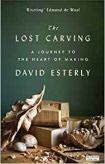The Lost Carving: A Journey to the Heart of Making by David Esterly
| The Lost Carving: A Journey to the Heart of Making by David Esterly | |
|
| |
| Category: Autobiography | |
| Reviewer: Rebecca Foster | |
| Summary: American woodcarver Esterly restored Grinling Gibbons's limewood carvings at Hampton Court Palace after a 1986 fire. Revisiting his diary from that year, he meditates on the role of brain vs. body in the creative process and asks how we can be faithful to history. | |
| Buy? Maybe | Borrow? Yes |
| Pages: 288 | Date: September 2014 |
| Publisher: Gerald Duckworth & Co | |
| External links: Author's website | |
| ISBN: 9780715649190 | |
| Video:
| |
Bouncing between his studio in upstate New York and the sites of various English sojourns, woodcarver David Esterly's seems to be an idyllic existence. Yet it's not all cosy cottages in the snow and watching geese and coyotes when he looks up from his workbench. There is an element of hard-won retreat from the trials of life in this memoir, but at the same time there is an argument for the essential difficulty of the artist's life. 'Carvers are starvers,' a wizened English carver once told him. Certainly there is no great fortune to be won from a profession as obscure as limewood carving, but the rewards outweigh the hard graft for Esterly.
As a student Esterly hadn't yet grasped the benefits of working with your hands. He stayed on at Cambridge to do a dissertation on W.B. Yeats and Neoplatonism. When he returned to America he swerved to the blue-collar extreme and hauled barrels of beer; 'All the while I pondered the foolishness of pendulum swings from all brain to all body.' One day in the 1970s Esterly walked into the Christopher Wren-designed church at St James's, Piccadilly with his partner, a fellow artist, and saw something that would change his life: a Grinling Gibbons woodcarving. Gibbons's pale limewood carvings are full of vines, fruits, flowers, birds and cherubs, all characterised by soft curves and lifelike textures.
Over the next three decades, Esterly has devoted himself to carving in the Gibbons style. It has been a process of linking knowledge and bodily skill, learning what Yeats called 'The Thinking of the Body'. Esterly describes carving as a trance-like state of letting your hands and the wood guide the way. I particularly loved the last lines of his prologue: 'The workroom begins to fade away. On go the hands. The mind slips its mooring and lets the river take it where it will.' The creative process makes him feel alternately like a god or a slave – sometimes in control of his work, other times in servitude to it. A block of wood represents pure possibility; his job is making the spaces through which silence and art appear.
Although the book meanders back and forth in time, its main concern is the year Esterly spent working on the restoration of the Grinling Gibbons carvings at Hampton Court Palace after the 1986 fire. The palace wanted him to donate his journals from that year to their archive, but he kept them instead, and this book is the result. Could he ever live up to Gibbons's greatness? This was Esterly's constant worry. His natural perfectionism and a desire to stay true to the historical record caused him to take some extraordinary measures, such as obtaining sharkskin and Dutch rush plants to use in the place of modern sandpaper. Still, he could not stop obsessing over a leaf rope he made a bit too bulbous compared to the original.
There were gentle surprises along the way. For instance, Esterly at first thought an underling from Gibbons's studio had carved some of the panels backwards – until it emerged that some of the Hampton Court carvings had been hung upside down for decades. He also ran up against a dispiriting level of palace bureaucracy: to start with, they only wanted English carvers; then they resisted lending out the restored carvings for a Gibbons exhibition.
You needn't be a craftsman yourself to enjoy this book, though some interest in the creative process is a good prerequisite. Indeed, this might be one to peruse alongside Matthew B. Crawford's The Case for Working with Your Hands. The black-and-white photographs, showing some of Gibbons's carvings as well as Esterly's own, are a highlight. If I was being uncharitable, I might say the book didn't need to be nearly 300 pages; 200 would do. Still, it's a subtle, meditative work, ideal for savouring a bit at a time.
Further reading suggestion: The Hare With Amber Eyes: A Hidden Inheritance by Edmund de Waal is another personal reflection on creativity and the magic of physical objects. You might also appreciate Redeeming Features by Nicky Haslam.
Please share on: ![]() Facebook,
Facebook, ![]() Twitter and
Twitter and
![]() Instagram
Instagram
![]() You can read more book reviews or buy The Lost Carving: A Journey to the Heart of Making by David Esterly at Amazon.co.uk Amazon currently charges £2.99 for standard delivery for orders under £20, over which delivery is free.
You can read more book reviews or buy The Lost Carving: A Journey to the Heart of Making by David Esterly at Amazon.co.uk Amazon currently charges £2.99 for standard delivery for orders under £20, over which delivery is free.
![]() You can read more book reviews or buy The Lost Carving: A Journey to the Heart of Making by David Esterly at Amazon.com.
You can read more book reviews or buy The Lost Carving: A Journey to the Heart of Making by David Esterly at Amazon.com.
Comments
Like to comment on this review?
Just send us an email and we'll put the best up on the site.


